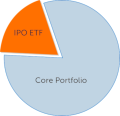Pershing Square Tontine Holdings (PSTHU) raised $4 billion and traded up 6.5% yesterday, becoming the largest Special Purpose Acquisition Company (SPAC) ever to go public. It is the latest milestone in a record-breaking year for SPACs.
To screen for upcoming or past SPAC IPOs, sign up for a free trial of IPO Pro.
2020 SPAC milestones
- The largest SPAC ever to go public: Pershing Square Tontine (PSTHU)
- The largest announced SPAC merger: Churchill Capital III (CCXXU) and MultiPlan ($11 billion)
- The first-ever SPAC IPO of common shares: Therapeutics Acquisition (TXAC)
- The best first-day pop for a SPAC: Therapeutics Acquisition (TXAC; +20% pop)
- The most SPAC proceeds raised in a year: $17.1 billion, with five months to go
- The biggest quarter ever by proceeds (tied for most deals): 2Q20, 24 SPACs and $7.2 billion
- On pace for a record-breaking year by deal count in 2020
- More companies choosing SPAC listings over IPOs
So far this year, 48 SPACs have raised $17.1 billion, representing 40% of all dollars raised in the 2020 IPO market. More SPACs have gone public than any other sector, leading healthcare (45 IPOs; $11.1B), technology (14; $4.0B), financials (7; $2.2B), and industrials (6; $4.3B). In a few cases this year, SPACs have set records, only to be topped months or weeks later. Churchill Capital Corp III (CCXXU) became the largest SPAC ever after its $1 billion February IPO, now dwarfed by Pershing Square Tontine. EcoR1's Panacea Acquisition (PANAU) had the biggest SPAC pop (+13%), before RA Capital's Therapeutics Acquisition the following week.
SPAC activity has trended higher for years, but high-profile success stories like Virgin Galactic (SPCE; $25.54), DraftKings (DKNG; $37.75), and Nikola (NKLA; $36.57) have been a driver behind some of the recent frenzy. SPAC proponents claim that a negotiated M&A deal is safer than the IPO process, but these deals also reinforce the idea that SPACs can take public a unique set of quality assets, which include moonshot companies or high-profile names that traditional IPO investors might normally avoid. Recently even traditional IPO candidates like biotech Immatics (IMTX; $10.73) and auto-tech Velodyne Lidar (GRAF.U; $19.00) agreed to SPAC mergers, while private equity-owned MultiPlan's (CCXXU; 11.50) plan to go public via $11 billion SPAC merger further cements this route as a viable IPO alternative.
SPACs have begun attracting long-term investors, though historically, hedge funds eagerly bought SPAC units at $10, sold the redeemable common shares for about the same price, and retained the warrant for potential upside at an acquisition. SPACs can be very lucrative for the founders, who retain a significant chunk of equity, along with the various advisers, lawyers, and bankers.
For investors after the acquisition, SPAC returns have been a mixed bag. The majority of SPACs that have completed acquisitions in 2020 trade below issue (13/22), which is also true of SPACs that completed acquisitions in 2019. That said, the space is arguably maturing, both in terms of the quality of companies beginning to be acquired and the management teams forming them. An encouraging sign: Pershing Square Tontine's sponsor will not make money unless public investors do.



